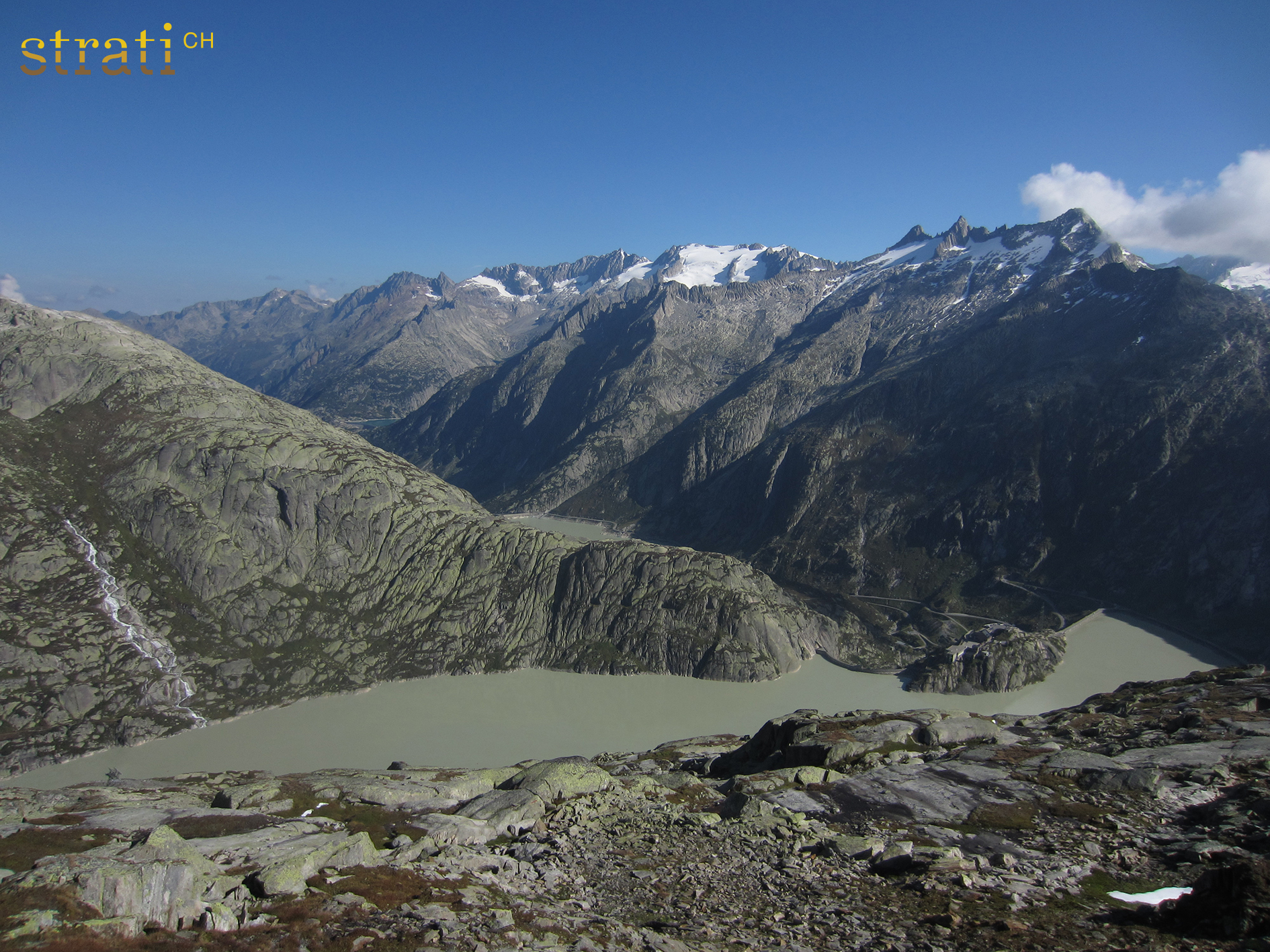Haslital-Gruppe (spät- bis postvariszische Intrusiva)
Torna a Massiccio dell'AarRappresentazione e statuto
- Colore CMYK
- (0%,42%,51%,12%)
- Colore RGB
- R: 225 G: 130 B: 110
- Rango
- Gruppo litostratigrafico
- Uso
- Unità in uso.
- Status
- termine informale
Nomenclatura
- Deutsch
- Haslital-Gruppe (spät- bis postvariszische Intrusiva)
- Français
- Groupe du Haslital
- Italiano
- Gruppo del Haslital
- English
- Haslital Group
- Origine del nome
-
Haslital (BE), Guttannen
- Varianti storiche
-
Group C (Schaltegger 1994), Grimselgranit-Komplex (Labhart 2007), Jüngere Granite (Spillmann et al. 2011), Late to post-Variscan plutonic rocks = Haslital Group (Berger et al. 2017), Group C = Haslital group (Ruiz et al. 2022), ZAGR-Clan
Gerarchia e successione
Età
- Geomorfologia
-
- Sakmarian
- Età alla base
-
- Gzhelian
Referenze
- Definizione
-
(2017) :
Geological Map of the Aar Massif, Tavetsch and Gotthard Nappes. Geological Special Map 1:100'000, Explanatory Notes 129
p.49: The Haslital Group (Tab. 2) was defined as the association of granitoid bodies forming a temporally and genetically coherent group, which intruded mainly during Asselian times (299– 295 Ma), i.e., at the Carboniferous /Permian boundary (Fig. 4). These plutonic rocks belong to a calc-alkaline to sub-alkaline granitoid suite (SCHALTEGGER 1994). The Haslital Group corresponds to “Group C” of SCHALTEGGER (1994, see also SCHNEEBERGER et al. 2016). Volumetrically, this group represents the largest association of Variscan plutonic rocks in the area covered by the map sheet. They intrude the polycyclic metamorphic basement of the Aar Massif as documented by primary magmatic intrusive contacts crosscutting the pre-Permian structures (Fig. 8). The Haslital Group comprises the Grimsel Granodiorite, Southwestern Aar Granite, the Central Aar Granite, the Mittagflue Granite and the Gastern Granite.
The plutonic rocks of the Haslital Group have suffered different degrees of Alpine deformation, wheras the Gastern Granite is only slightly affected by Alpine deformation. Other members frequently show a gneissic structure. In the Haslital, the Alpine deformation is most intense in the central section of the Central Aar Granite, with increasing strain gradient towards the Grimsel Granodiorite, which represents the most strongly deformed rock type (WEHRENS 2015, SCHNEEBERGER et al. 2016, WEHRENS et al. 2017).
-
Mittagflue-Granit
- Name Origin
-
Mittagfluh = Mittagflue (BE), 2 km SE Guttannen
- Rango
- Formazione litostratigrafica
- Statuto
- termine informale
- In breve
-
Spät- bis postvarizischer, hellgrauer gleich- und mittelkörniger Biotitgranit des Aar-Massivs (heller und feinkörniger als der Zentrale Aare-Granit), oft massig, längs Südrand stark mylonitisiert. Kommt zwischen den Gneisen des Ofenhorn-Stampfhorn- und des Guttannen-Gneiskomplexes vor.
- Age
- Asseliano
-
Hinterbalm-Granit
- Name Origin
- Rango
- unità litostratigrafia
- In breve
- Massiger feinkörniger Granit.
- Age
- Cisuraliano (= Primo Permiano)
-
Balmenegg-Granit
- Name Origin
-
Balmenegg (UR), Maderanertal
- Rango
- unità litostratigrafia
- In breve
- Grünlicher, porphyrischer Biotitgranit (spät- bis postvariszisch?).
- Age
- Cisuraliano (= Primo Permiano)
-
Zentraler Aare-Granit
- Name Origin
- Rango
- Formazione litostratigrafica
- Statuto
- termine informale
- In breve
-
Spätvariszischer (nur alpin deformiert), heller, meist massig bis zum Teil stark geschieferter, grobkörniger Biotitgranit (kalkalkalisch) des Aarmassivs.
- Age
- Gzhelian
-
Aplitische Randfazies des Zentralen Aare-Granits
-
Varietät «Unter der Flue» des Zentralen Aare-Granits
- Name Origin
-
Quartierteil Unter der Flue (UR) im Maderanertal
- Rango
- unità litostratigrafia
- Statuto
- termine locale (informale)
- In breve
-
Saure Randfazies des Zentralen Aare-Granits.
-
Varietät «Beesten» des Zentralen Aare-Granit
- Rango
- facies petrografica
- Statuto
- termine locale (informale)
- In breve
-
Feinkörnige porphyrische Varietät des Zentralen Aare-Granit.
-
Telltistock-Granit
- Name Origin
- Rango
- unità litostratigrafia
- In breve
-
Spät- bis postvariszischer (301.2 +/-1.5 Ma), fein- bis mittelkörniger Biotitgranit, teilweise kataklastisch bis mylonitisch überprägt.
- Age
- Late Pennsylvanian
-
Südwestlicher Aare-Granit
- Rango
- Formazione litostratigrafica
- Statuto
- termine scorretto (informale)
- Nomenclatorial Remarks
- <p>Vorschlag: Märjelen (VS)?</p>
- In breve
-
Spät- bis postvarizischer (ca. 296.1 Ma) Granit des Aar -Massivs südlich des Grimselpasses (Obergomsgebiet).
- Age
- Primo Permiano
-
Strem-Granit
- Name Origin
- Rango
- Formazione litostratigrafica
- Nomenclatorial Remarks
- <p>Südlicher Aare-Granit p.p., Southern Aar Granite p.p.</p>
- In breve
-
Variszischer grauer porphyrischer kalkalkalischer Granit des südöstlichen Rand des Aar-Massivs.
- Age
- Pennsylvanian
-
Grimsel-Granodiorit
- Name Origin
- Rango
- Formazione litostratigrafica
- Statuto
- termine informale
- Nomenclatorial Remarks
- <p>südliche Randzone des ZAG</p>
- In breve
-
Spät- bis postvarizischer (297.2 +/-1.0 Ma), grünlicher, mehrheitlich grobkörnig-porphyrischer, Biotit führender Granodiorit bis Granit (dunkler als der Zentrale Aare-Granit), bzw. grobflaseriger Augengneis.
- Age
- Gzhelian
-
Rossbodenstock-Diorit
- Name Origin
- Rango
- unità litostratigrafia
- Statuto
- termine informale
- Nomenclatorial Remarks
- <p>non: Granitporphyr vom Rossbodenstock (Ambühl 1929) >>> Rossbodenstock (GR), Tujetsch = Metadiorit-Linsen der Gotthard-Decke !!!</p>
- In breve
-
Spät- bis postvariszischer (298.6 +/-1.0 Ma), massiger, grobkörniger, Hornblende führender Biotit-Quarzdiorit.
- Age
- Tardo Carbonifero

